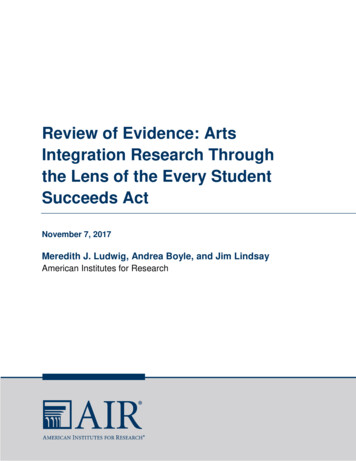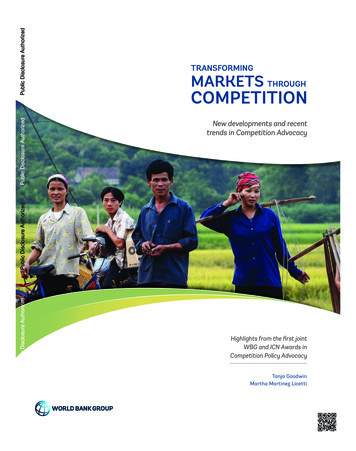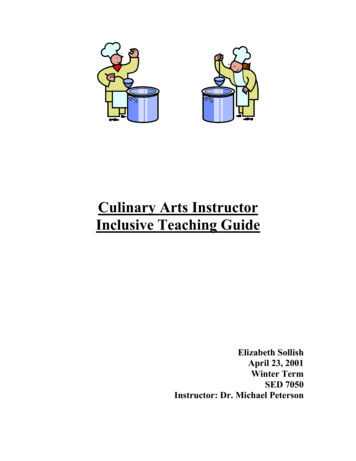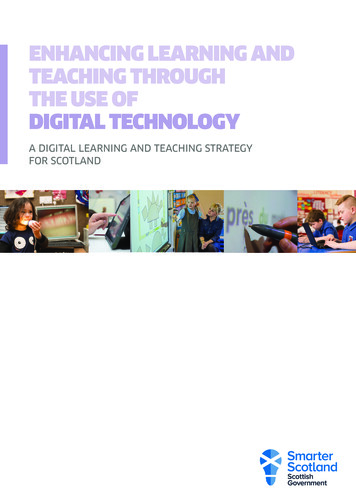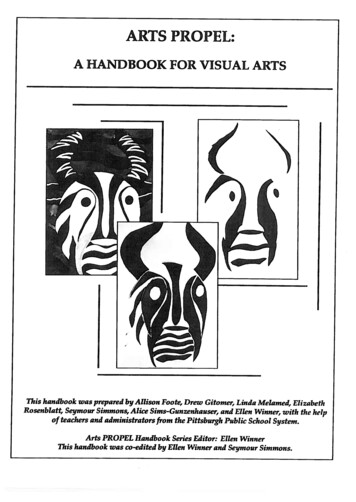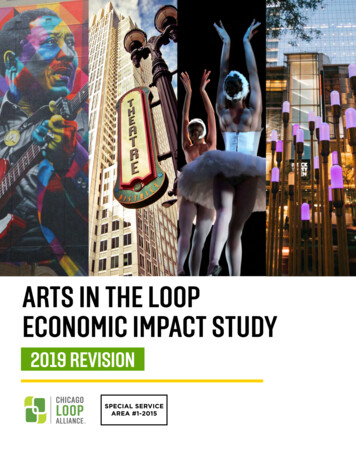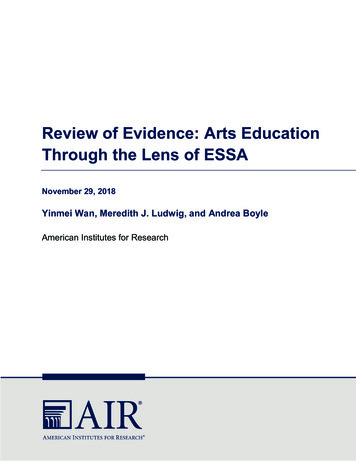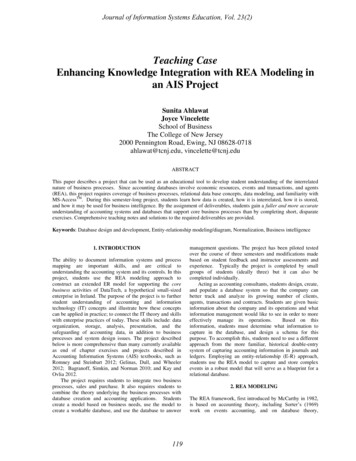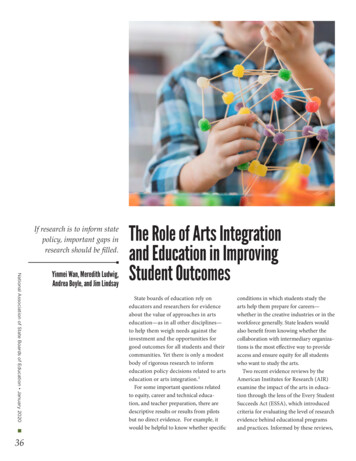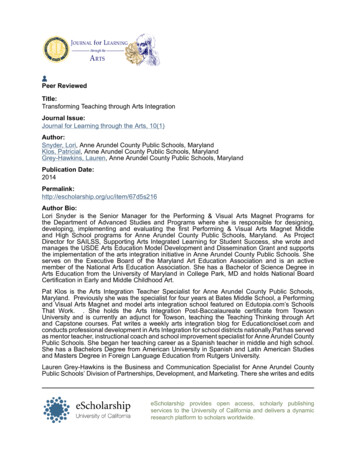
Transcription
Peer ReviewedTitle:Transforming Teaching through Arts IntegrationJournal Issue:Journal for Learning through the Arts, 10(1)Author:Snyder, Lori, Anne Arundel County Public Schools, MarylandKlos, Patricial, Anne Arundel County Public Schools, MarylandGrey-Hawkins, Lauren, Anne Arundel County Public Schools, MarylandPublication /67d5s216Author Bio:Lori Snyder is the Senior Manager for the Performing & Visual Arts Magnet Programs forthe Department of Advanced Studies and Programs where she is responsible for designing,developing, implementing and evaluating the first Performing & Visual Arts Magnet Middleand High School programs for Anne Arundel County Public Schools, Maryland. As ProjectDirector for SAILSS, Supporting Arts Integrated Learning for Student Success, she wrote andmanages the USDE Arts Education Model Development and Dissemination Grant and supportsthe implementation of the arts integration initiative in Anne Arundel County Public Schools. Sheserves on the Executive Board of the Maryland Art Education Association and is an activemember of the National Arts Education Association. She has a Bachelor of Science Degree inArts Education from the University of Maryland in College Park, MD and holds National BoardCertification in Early and Middle Childhood Art.Pat Klos is the Arts Integration Teacher Specialist for Anne Arundel County Public Schools,Maryland. Previously she was the specialist for four years at Bates Middle School, a Performingand Visual Arts Magnet and model arts integration school featured on Edutopia.com’s SchoolsThat Work. . She holds the Arts Integration Post-Baccalaureate certificate from TowsonUniversity and is currently an adjunct for Towson, teaching the Teaching Thinking through Artand Capstone courses. Pat writes a weekly arts integration blog for Educationcloset.com andconducts professional development in Arts Integration for school districts nationally.Pat has servedas mentor teacher, instructional coach and school improvement specialist for Anne Arundel CountyPublic Schools. She began her teaching career as a Spanish teacher in middle and high school.She has a Bachelors Degree from American University in Spanish and Latin American Studiesand Masters Degree in Foreign Language Education from Rutgers University.Lauren Grey-Hawkins is the Business and Communication Specialist for Anne Arundel CountyPublic Schools’ Division of Partnerships, Development, and Marketing. There she writes and editseScholarship provides open access, scholarly publishingservices to the University of California and delivers a dynamicresearch platform to scholars worldwide.
publications, grants, websites, and other informational material supporting and promoting AnneArundel County’s schools. She has a Bachelor of Arts Degree in English from St. Mary’s Collegeof Maryland.Keywords:Arts Integration;Middle School Model, Arts Education, Middle School ReformLocal Identifier:class lta 19308Abstract:Transforming Teaching through Arts IntegrationAI Implementation Results: Middle School Reformthrough Effective Arts Integration Professional Development In four years, Anne Arundel CountyPublic Schools (AACPS) increased sixth and seventh grade student achievement on the MarylandState Assessment (MSA) by 20% at Bates Middle School, a low performing school that hadbeen targeted for restructuring by the state. This improvement positively correlates with theimplementation of the arts integration Supporting Arts Integrated Learning for Student Success(SAILSS) model funded through the Arts in Education Model Development and Dissemination(AEMDD) grant. This model, offered to teachers across all content areas, incorporates extensiveprofessional development opportunities including: an intensive weeklong workshop for teacherswith artists followed by a two-week teaching lab with students; participation in an cohort toachieve an arts integration post-baccalaureate certificate,; and extensive trainings, conferencesand workshops at local, regional, and national schools, museums, arts institutes, and highereducation facilities. Qualitative and quantitative data collected by AACPS was assessed througha quasi-experimental design from the treatment and comparison schools utilizing the followinginstrumentation: state and local standardized testing, School-level Environment Questionnaire(SLEQ), Arts Integration: Classroom Observations for Middle Schools (AICOM), arts integrationlogs and parent, student, and teacher surveys. Through this study we found that in addition toincreasing student achievement on statewide assessments, implementing this arts integrationmodel positively correlates with a 77% decline in discipline referrals, and overall positive changein school climate based on teacher, staff, student, and parent perception.Copyright Information:All rights reserved unless otherwise indicated. Contact the author or original publisher for anynecessary permissions. eScholarship is not the copyright owner for deposited works. Learn moreat http://www.escholarship.org/help copyright.html#reuseeScholarship provides open access, scholarly publishingservices to the University of California and delivers a dynamicresearch platform to scholars worldwide.
Snyder et al.: Transforming Teaching through Arts IntegrationTransforming Teaching through Arts IntegrationAI Implementation Results: Middle School Reform throughEffective Arts Integration Professional DevelopmentLori SnyderAnne Arundel County Public Schools, MarylandPatricia KlosAnne Arundel County Public Schools, MarylandLauren Grey-HawkinsAnne Arundel County Public Schools, Maryland1
Journal for Learning through the Arts, 10(1) (2014)AbstractIn four years, Anne Arundel County Public Schools (AACPS) increased sixth and seventhgrade student achievement on the Maryland State Assessment (MSA) by 20% at Bates MiddleSchool, a low performing school that had been targeted for restructuring by the state. Thisimprovement positively correlates with the implementation of the arts integration Supporting ArtsIntegrated Learning for Student Success (SAILSS) model funded through the Arts in EducationModel Development and Dissemination (AEMDD) grant. This model, offered to teachers across allcontent areas, incorporates extensive professional development opportunities including: an intensiveweeklong workshop for teachers with artists followed by a two-week teaching lab with students;participation in an cohort to achieve an arts integration post-baccalaureate certificate,; and extensivetrainings, conferences and workshops at local, regional, and national schools, museums, artsinstitutes, and higher education facilities. Qualitative and quantitative data collected by AACPS wasassessed through a quasi-experimental design from the treatment and comparison schools utilizingthe following instrumentation: state and local standardized testing, School-level EnvironmentQuestionnaire (SLEQ), Arts Integration: Classroom Observations for Middle Schools (AICOM),arts integration logs and parent, student, and teacher surveys. Through this study we found that inaddition to increasing student achievement on statewide assessments, implementing this artsintegration model positively correlates with a 77% decline in discipline referrals, and overallpositive change in school climate based on teacher, staff, student, and parent perception.2
Snyder et al.: Transforming Teaching through Arts IntegrationIntroductionAnne Arundel County Public Schools (AACPS) was struggling to reform Wiley H. BatesMiddle School (Bates), a highly diverse, low-income school on the brink of failure in Annapolis,Maryland. Bates Middle School, part of the Annapolis High School Feeder System serves a diverseGrade 6-8 community that includes five nearby federal housing project communities. Four out of thefive elementary schools that feed into Bates are designated as Title I schools, and 48% of thestudents at Bates qualify for Free and Reduced Meals (FARMs). In addition, the population (749students) of the school itself is extremely diverse with a high minority population and a highpercentage (18%) of students receiving special support (Table 1).Table 1Wiley H. Bates Middle School 2012-2013 student demographics compared with AACPSTwo ormoreAfricanSchoolMale 8%10%AACPS51%49%4%20%10%5%60%9% 5%Source: http://www.mdreportcard.orgIn the fall of 2010, Bates Middle School did not meet Adequate Yearly Progress (AYP) forthe third consecutive year, indicating that Bates was not on track to meet Anne Arundel County’sgoal of 100% proficiency by 2014 for No Child Left Behind. In addition to indicators of a strugglingschool climate, such as a high number of referrals, students at Bates were below the county averagein achievement on the Maryland State Assessment (MSA) for Reading and Mathematics (Table 2).Table 2Percentage of students scoring Proficient or Advanced on the MSAMathematicsReadingGradeWiley H. BatesMiddle SchoolAACPS MiddleSchool aced with scores 14%-27% behind the county average, Bates was marked for Corrective Action(the third and highest tier of school improvement) by AACPS. We, the administrators and leaders inthe county, sought a full-school approach that could change not only the achievement, but also theculture, of the entire school. To meet this need, we turned to Arts Integration (AI).Burnaford (2007) placed the origin of Arts Integration in the early 1900s, when educatorsstarted to challenge the organization of the secondary school curriculum as a group of insulatedcontent areas. Proposals to reform secondary schools included reorganizing the curricula by themes,rather than content areas; embedding interdisciplinary topics into content-specific curricula; andadopting a full integration model. Gardner’s (1983) theory of multiple intelligences wasinstrumental to the Arts Integration movement. In the early 1980s, Gardner advanced the conceptthat human beings have different intelligences that account for their broader range of potential. Histheory highlighted the need to reach students’ different intelligences by diversifying teachingmethods. Art, with its many forms (visual, dance, music, drama), addressed this need fordiversification (Nelson, 2001). The integration of art into the academic content curricula provides alogical approach to address the variety of students’ intelligences that are reflected in their differentlearning styles.3
Journal for Learning through the Arts, 10(1) (2014)This integration is further supported by research demonstrating that implementing ArtsIntegration can raise student achievement and engagement in students from both low and highsocioeconomic backgrounds (Catterall, Dumais, & Hampden-Thompson, 2012). Gallas (1994)found that the arts provide varied, connected, and increasingly challenging opportunities to generateknowledge, a claim supported by Erickson (2000), who found that Arts Integration allows for anatural, meaningful connection among one or more art forms and one or more subject areas to helpstudents master significant content and/or skills in both. The link between arts and achievement isespecially true for mathematics (TIMMS, 2004). Through a series of studies conducted over the pasttwo decades, researchers have found that music in particular is linked to high school mathproficiency. As one example, a 2002 study found that students involved in music classes duringtheir high school careers are significantly more likely to score higher on standardized mathematicsexams, such as the SAT (Vaughn, 2002). Furthermore, this correlation is especially true for studentsfrom underrepresented populations, with research finding that low-income students involved inorchestra were more than twice as likely to perform at the highest mathematics level than their peersnot involved in music (Catterall, Chapleau, & Iwanaga 2002). Armed with this knowledge, AACPSembraced Arts Integration as the vehicle for full-school reform at Bates.Using funds awarded by the 2008 Arts Education Model Development and Dissemination(AEMDD) grant, Anne Arundel County Public Schools (AACPS) designed the Supporting ArtsIntegration Learning for Student Success (SAILSS) project as a middle school model of full- schoolArts Integration. The SAILSS project was guided by two major resources. The first was ArtsIntegration Frameworks, Research and Practice, a report citing more than 35 significant researchstudies linking the arts to higher academic performance and the development of social skills(Burnaford, Brown, Doherty, & McLaughlin, 2007). This literature review provided a theory-drivenframework of best practices upon which we designed our SAILSS model, includingrecommendations for cross-disciplinary collaborative planning, professional development,community involvement, and direct interactions with art/artists. The second resource, An ArtsIntegrated Approach for Elementary School Students, provided the guiding questions to ensure thatthe SAILSS model remained accountable and sustainable:What is the content? What is appropriate instruction? Who provides the instruction? Whatstrategies are implemented? How will assessment occur? (Brown, 2007).Following these resources of best-practices the SAILSS project involved the design andimplementation of a school-wide instructional model that integrated the learning of different artforms into the core content areas. This model included a triad of teacher-driven activities thatincluded sustained and focused professional development, curriculum writing, and curriculumimplementation . Art-related enrichment activities were also planned to bring the project beyond theschool walls and involve the community. Specifically, the SAILSS model included the followingkey components:1. Commitment by the school administration to implement AI
Transforming Teaching through Arts Integration Journal Issue: Journal for Learning through the Arts, 10(1) . serves on the Executive Board of the Maryland Art Education Association and is an active member of the National Arts Education Association. She has a Bachelor of Science Degree in Arts Education from the University of Maryland in College Park, MD and holds National Board Certification .File Size: 1MBPage Count: 26
